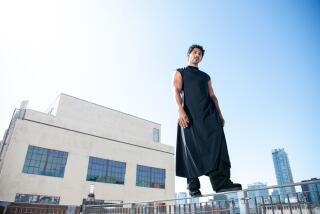Let’s Have a Necktie Party : Fashion: Shopping for a tie today is an adventure in a colorful, often expensive land. Men can choose from artistic abstracts, frolicking women and ‘40s flora and fauna.
- Share via
When Eric Corwin, a KABC sports producer, returned a Christmas-gift shirt to Nordstrom, he expected to get a nice tie and perhaps some socks in exchange. Instead, he forked out an additional $35 for the tie of his choice and never got around to the socks.
At $65, the hand-screened, hand-sewn silk by XMI, cost more than any of Corwin’s previous ties, but he says it was worth it. Not only does it draw constant comments, it weaned him from his old habit of letting girlfriends choose $25- to $30-ho-hum styles and turned him into an eager buyer on the lookout for ties with clout.
According to a 1989 survey conducted for British-based Tie Rack (which specializes in $15-to $35-neckwear and has 42 stores in the United States), the average American male spends $15 for a tie.
But the “average” fashion hound nationwide spends closer to $50--with many of them willing to splurge $100 or more for that special little something.
As Corwin quickly learned, shopping for neckwear in 1990 is an adventure in an amazing land of expressive, often expensive, colorful expanses (most ties now tend to be 3 1/2 to 4 inches wide) covered with everything from artistic abstracts and whimsical dots to ‘40s flora and fauna, frolicking women and trompe l’oeil interiors.
The market has exploded with the most exciting designs and patterns anyone can remember, thanks to two camps: clothing designers, such as Giorgio Armani, who added ties (virtually all of them silk, worn summer and winter) to their repertoires; and the witty, innovative neckwear specialists such as Tie Rack, Modules, Format, Paul Smith, Howard Behar and Brian Bubb.
On the receiving end are men more interested than ever in shopping for their own clothes. As that clothing grows more costly, they have learned a few tricks from women.
New ties work wonders on older clothes and stretch a wardrobe: Change the tie (and the shirt) and a man can wear the same suit day after day if he has to.
Best of all, they allow a man to express his individuality and rise above the maddening concept of the blue, black, gray and white corporate world.
The creme de la creme of today’s ties do far more than conceal shirt buttons and catch crumbs. They’re fun but not frivolous, gutsy but not garish. And they’re not about to be phased into obsolescence. The no-tie look might work at night. But for daytime, and for most men, a tie remains the most important accessory.
“For me, it’s the icing on the cake. The only choices I have when I get up in the morning are the suit and the tie. The rest is always a white shirt, dark socks and dark shoes,” explains Daniel Riganati, an East Coast executive who owns 30 ties and normally pays $25 to $30 “for a decent tie.”
But typical of the trend, Riganati’s most recent purchase--a Fendi suggested by a saleswoman in Dallas--cost $50.
“I didn’t like it at first, but then it grew on me,” he laughs. “People love it. It looks like a lava lamp. It’s very primitive, very Fred Flintstone.”
Loren Miles, president of Miles Communications Group in Los Angeles, says he will go as high as $140 or $150 for his ties.
But his personal average “is usually $80 to $125. I’ve definitely graduated,” concedes the 34-year-old executive. “I started out paying $15 to $20.” Six years ago he got into the expensive clothing habit, which necessitated changes: “When you wear an Armani suit, you don’t wear a cheap tie with it.”
Miles gets the proper reflection from ties by Armani, Byblos, Kenzo, Gianni Versaci, Jean Paul Gaultier and Comme des Garcons. Some of which he and his wife, who also buys his ties, find at Maxfield on Melrose Avenue, where occasionally “they are on sale for $50 or $60, a great price.”
Sales are a great way to beat the high cost of ties. So is shrewd shopping in discount and thrift stores. (Even Miles has a tie from a thrift store--but it cost $50.)
John Mather, Esquire magazine’s fashion editor, suggests one more route: “Our readers are buying better but less. Instead of four or five ties, they’re buying just two that they love.”
To recognize a tie worthy of true love, Lorri Maake, president of Tie Rack (U.S.) Inc. says turn it over and check for a horizontal strip made of the same fabric as the tie and a label, bar tacks (reinforced stitching) and silk facing (also known as tipping) at either end of the tie and a loop or a long piece of extra thread at the narrow end.
“Some people clip that off, which is a mistake,” Maake cautions. “Silk fabric stretches during the lifetime of a tie. Unless there is some extra thread there, the stitching will bunch.”
Feel for a lightweight interlining through the body of the tie. Too much bulk will hinder today’s fashionable small knot (a four-in-hand is preferred by Alan Flusser, the New York retailer-designer-author who created Michael Douglas’ “Wall Street” wardrobe).
In addition, the outside silk shell “should feel lustrous and supple-- moist is the expression we use. You don’t want it to feel dry and rough,” Maake explains.
To go with the custom-tailored clothing Flusser offers in his three East Coast shops (two in Manhattan, one in Washington), he stocks $65- and $75-ties made by hand in London.
Although he doesn’t sell the label, he says: “If there is one status tie identified with corporate style today, it is the Hermes” (found locally at the Hermes boutique in Beverly Hills and at Neiman Marcus for $95).
If a man can’t afford a stack of ties at today’s prices, Flusser recommends: “Buy something simple that isn’t remembered every time you wear it.” And never send it to the cleaners. “A tie has a certain sponginess to it. When it’s dry-cleaned and steamed, you loose that character. And in many cases, the spot doesn’t come out.”
Flusser’s only advice is to rub the spot while it is still fresh with a clean section from the inside of the tie in hopes of removing some of the stain.
Samantha Roldan, Brian Bubb’s business partner, also votes against dry-cleaning. Her recommendation is: “Baby powder. Sprinkle it on, let it sit and brush it off. It’s great for absorbing oils.” She has also used K2R, a spray-on spot remover available in drugstores and supermarkets.
To get mileage from a good tie, Roldan suggests: “Buy one with many different colors.”
Bubb agrees, but points out, “It depends if you’re an IBM man or an art director. If a man has to wear something subtle, he has to be a little bit careful. For me, the requisite is that you really love the tie and feel great about it. That supersedes all else.”
Explaining the high price of ties, Roldan says: “When I started out in the industry 15 years ago, you could buy quality silk for about $9.95 a yard. Now it’s around $23.50 a yard.”
Adds Jodi Bynum, divisional merchandise manager for Neiman Marcus: “Any time you have more than three colors, you really start building the price, because each color requires it’s own silk screen.”
“If you look at a tie as such a small piece of fabric compared to other articles you wear, it does seem to be a great expense,” muses well-dressed costume designer Michael Kaplan, who buys new ties at Neiman’s, Robinson’s and Clacton & Frinton, a men’s boutique in Los Angeles; vintage ties at American Rag Cie, in Los Angeles; and orders custom-made neckwear from Byllee , also in Los Angeles.
In defense of expensive ties (“a $50 tie holds the knot better than a cheaper one”) Kaplan notes: “I think a tie determines the whole mood of what you’re wearing. You can have on the most beautiful suit, but if you put on an unattractive or cheap tie or one that doesn’t go with it, you can ruin the whole look.” On the other hand, combine a basic suit with a great tie, he says, “and you can create the whole look.”
Kaplan appreciates a strong statement. but cautions: “Ties have their own personalities. When you’re buying one, you have to be careful it is in sync with your personality and what you’re trying to say.”






